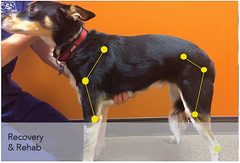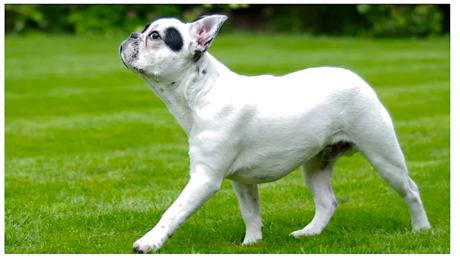
The manner, in which a dog ambulates or walks, is called “gait”.
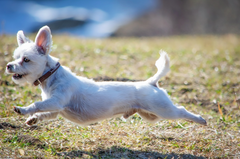
Gait patterns
Now, let’s take a look at the various patterns of gait for quadruped animals, those that walk on four limbs:
Walking
Usually, a dog will start walking from the hind limb, often the left. Walking is a slow, 4-beat gait: L hind followed by R front followed by R hind then L front limb.
Amble
Amble describes a fast walk.
Trot
The trot is a 2-beat, diagonal gait. The L hind moves with the R front limb, and then the R hind moves with the L front limb.
Flying trot
Fast trot is referred to as flying trot.
Pace
The pace is a 2-beat, same-side gait. The L hind moves with the L front, then the R hind/front move together. Pacing often appears like a rolling or waddling gait. It is a normal gait in certain long-limb canine breeds such as Weimaraners.
Pacing is often abnormal and may occur in dogs having pain or weakness. Pacing is a way of walking with minimal energy output, similar to pendulum swinging of the limbs from the spine.
Canter
Canter is a fast 3-beat gait; L hind moves together with diagonal R front, then R hind and L front separately. Many people think the canter is only seen in horses, but it does occur in dogs. I think of it like ‘skipping’ and a frolicking type of gait seen often in toy breeds such as the Min Pin.
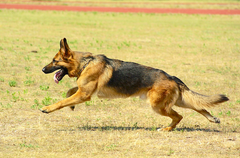
Gallop
Sometimes called running, typically both hind limbs push off at the same time, held closely together, followed by the front limbs individually. In some gallops, there is a moment in the cycle where all paws are up off the ground.
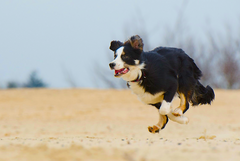
Abnormal gait patterns
The final area of gait evaluation consists of deviations or abnormal patterns seen in dogs with injury, pain, disability or disease.
There are too many to discuss in one article and always new ones observed that aren’t in the textbooks! Here is my top 10 list of the most common. If you recognize one of these in your pet it might give you a clue as to what is going on, and then check it out professionally with your dog’s veterinarian or physical therapist.
Antalgia
Antalgia, or limping refers to the dog lifting the limb up off the ground too early in the cycle, favoring it. It also means the dog is spending less time on that limb in the stance phase of the gait cycle. Antalgia is an indication of pain.
Ataxia
Ataxia refers to staggering or moving clumsily, unable to balance or control movements well. It indicates neurological problems in the brain (brainstem or cerebellum), spinal cord or vestibular problems from the ear.
Choppy gait
Choppy gait describes quick, short stride lengths often seen in dogs with hip dysplasia, hip arthritis, and shoulder arthritis
Circumduction
Circumduction is a circular, arc-like swinging of the limb during gait, due to tightness in the spine or stiffness of the stifle or elbow joints.
Floating
Floating can be observed when the dog’s front limbs move in an irregular high step or prancing fashion and the front of the body looks like it is floating or lifting up off the ground. This indicates instability in the neck or neurological problems arising from the upper spine.
Head bob
Head bob describes the gait during which the dog’s head bobs up and down during each step, in an over exaggerated style. This usually indicates pain on stepping due to arthritis, bone spur, soft tissue injury, paw injury, etc. The excessive head and neck movement is an attempt to take the weight off the painful area during the stance phase of gait.
Hitching
Hitching is typically seen in the rear limb, a hiking-up or jerking- up motion at the hip, indicates tightness, stiffness or pain in the lumbar or sacroiliac joints, hip, pelvis or stifle and occurs during the swing, non-weight bearing gait phase.
Knuckling

 100vw, 200px” style=”box-sizing: border-box; vertical-align: middle; border-style: none; height: auto; max-width: 100%;”><figcaption><em>Scissoring</em></figcaption></figure>
</div>
<p>This term describes a gait during which the dog’s hind limbs are held very closely together or crossed over each other during gait. It usually indicates spastic nerve problems coming from pressure on the spinal cord but can also be seen in Degenerative Myelopathy.</p>
<p>Scissoring can occur with the front limbs and that is normal in some dog breeds.</p>
<h4><span>Steppage</span></h4>
<p>Steppage is an exaggerated lifting of the entire limb off the ground during the swing phase of gait, occurring when there is weakness or loss of control of the paw movements. It is usually associated with drop-paw, trauma, neuropathy, peripheral nerve injuries (those that occur away from the spine and spinal cord.</p>
<p>Author: <span style=) Susan E. Davis PT
Susan E. Davis PT
Link: https://mydogsymptoms.com/understanding-canine-gait/
For more on Gait Analysis & Rehab, check this out:
Need a virtual consult with a rehab expert? Click below:



